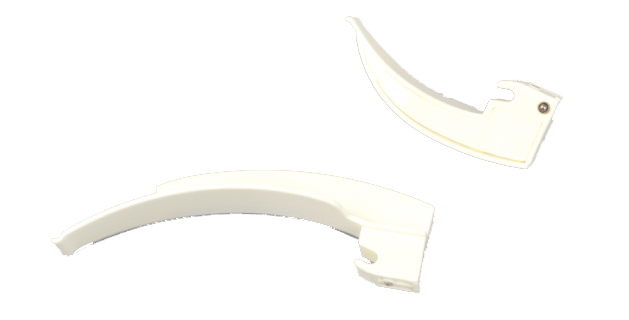
Disposable Laryngoscope
Looking to buy disposable laryngoscope blades? If so, you need not think twice in choosing the best or world-class range of products from Nexgen Medical. This brand has been widely praised for their finest qualities.
The disposable laryngoscope, with or without handle & battery.
If you are in the market for a new laryngoscope blade, you may be wondering whether the Nexgen Medical Disposable Anatomic Laryngoscope Blade is the right choice for you.we will take a look at some of the key features of this laryngoscope blade to help you make your decision. The Nexgen Medical Disposable Anatomic Laryngoscope Blade is designed for use with an Macintosh handle and features a curved blade design. The blade is made from stainless steel and is disposable, meaning that it can be safely disposed of after use. The blade is also available in two different sizes - 3.5 and 4.0 - to suit your individual needs.
One of the key features of this laryngoscope blade is its anatomically correct design. This means that the blade has been specifically designed to provide optimal visibility of the vocal cords, making it easier to intubate patients. The blade also features a serrated leading edge, which helps to improve gripping and avoid slippage when inserting the blade into the patient's mouth. Overall, the Nexgen Medical Disposable Anatomic Laryngoscope Blade is an excellent choice
When it comes to laryngoscopes, there are a few different types available on the market. The most common type is the rigid laryngoscope, which is composed of a handle and a blade. The blade is inserted into the patient's mouth and used to visualize the vocal cords. A fiberoptic laryngoscope uses a small camera at the tip of theblade to provide a clear view of the vocal cords. This type oflaryngoscope is often used when intubating difficult airways.
A flexible laryngoscope is another option that can be used to visualize the vocal cords. This type of laryngoscope consists of a flexible tube with a light source and a camera at the tip. The advantage of this type of laryngoscope is that it can be inserted through smaller openings, such as the nostrils. The best type of laryngoscope for you will depend on your individual needs. Talk to your doctor or ENT specialist to determine which type would be best for you.
Nexgen Medical's disposable anatomic laryngoscope blades are a great choice for those looking for a safe, reliable mechanical blade option. Here are some reasons why: -They're consistent. With Nexgen's advanced manufacturing process, you can be sure that each blade is identical in size and shape. This makes for more predictable results and fewer complications. -You'll save time. There's no need to sterilize these blades between uses, which means you can save time and get patients through your clinic more quickly. -They're easy to use. These blades are designed for easy insertion and removal, so you can focus on the procedure, not the equipment.
We all know that feeling when our blades start to feel dull and we're not sure why. Sometimes it's hard to tell if it's just the daily wear and tear or if we need to replace our laryngoscope blades. Here at Nexgen Medical, we want to make sure you have the best tools for the job, so let's talk about when you should replace your laryngoscope blades. As with any medical tool, over time laryngoscope blades will start to show wear and tear. This can be from daily use or even storage in less than ideal conditions. While you may be able to get by with a little sharpening here and there, eventually the blade will become too dull to use effectively. When this happens, you'll notice that it becomes harder to get a clear view of the vocal cords and you may find yourself struggling to insert the blade into the patient's mouth. If you find yourself having to force the blade or use excessive pressure, it's time to replace the blade. At Nexgen Medical, we offer a variety of disposable laryngoscope blades to fit your needs. Whether you're looking for a standard blade or something more specialized, we have what you
Like any other disposable medical device, there will come a time when the blades on your Nexgen anatomic laryngoscope need to be replaced. Here are some signs that it might be time for a fresh set of blades: The blades are dull or damaged. You’re having difficulty getting a clear view of the vocal cords. The blades slip or slide during use. You notice that the colors of the light emitted by the blade are faded or distorted. If you notice any of these issues, it’s probably time to replace the blades on your Nexgen laryngoscope. Fortunately, replacement blades are readily available and relatively affordable, so you can keep using your Nexgen laryngoscope with minimal interruption.
Nexgen Medical's disposable anatomic laryngoscope blades are a great option for those who are looking for a quality blade that is easy to maintain. Here are a few tips on how to keep your blades in good condition: 1. always handle the blades with care -never force them into place or bend them excessively as this can damage the delicate structure of the blade. 2. Keep the blades clean -disposable blades can be cleaned with isopropyl alcohol before and after each use. This will help to remove any debris or bacteria that may be present on the surface of the blade. 3. Inspect the blades regularly - after each use, take a close look at the blade to check for any cracks or damage. If you notice any damage, dispose of the blade and replace it with a new one. By following these simple tips, you can ensure that your Nexgen Medical disposable anatomic laryngoscope blades will provide you with years of reliable service.
e job done right. So don't settle for less - trust Nexgen Medical to give you the best laryngoscope blades on the market today.